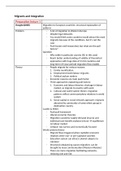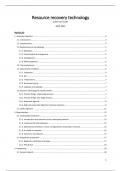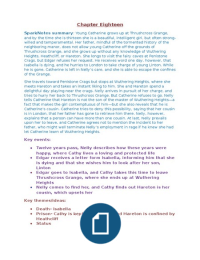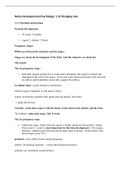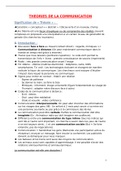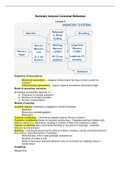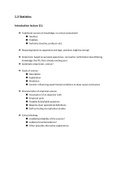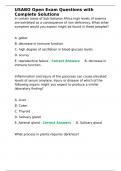Business Analytics Summary
Part I Introduction
1. What is Business Analytics
Gartner defines
Business analytics as a solution that creates scenarios, predicts future states, and is delivered as
an application for business users. It includes data mining, predictive analytics, applied
analytics, and statistics.
What does this mean?
Business analytics helps answer questions related to profit drivers, customer behaviour, logistics
optimization, and financial forecasting
How can this be achieved?
Business analytics is achieved by studying both internal and external data sources using
statistical tools and visualization tools to find meaningful patterns.
The difference between Business Analytics and Business Intelligence?
The difference between the course "Business analytics" and "Business intelligence
fundamentals" is that the latter focuses on reporting, while the former focuses on
understanding, predicting, and forecasting through statistical tools.
Is analysis difficult to do?
Business analytics requires a way of thinking that involves identifying interesting patterns,
selecting the appropriate analysis technique, and determining if the patterns found are
meaningful. It is not just a technical knowledge or knowing how to use software.
2. Conducting Quantitative Analysis
Qualitative vs Quantitative Analysis
Qualitative analysis involves talking and listening, while quantitative analysis involves analysing
data.
The Three Stages of Quantitative Analysis
The three stages of quantitative analysis are collecting data through surveys, finding interesting
patterns, and using statistical tools to analyse the data. Understanding customer behaviour is
a common goal for businesses in this field. It is important to learn how to find relevant patterns,
as more data becomes available in society. The basic elements of statistics will be introduced
before elaborating on the different steps in an analysis.
1
, Rania El Ghalbzouri – IBT B
3. Basic Concepts
Variables
"Variables" are the properties we try to measure in a population or a sample. In a sample of
students, we can measure gender, study program, date of enrolment, favourite colour, etc…
Quantitative vs Qualitative Variables
Quantitative variables have values represented by numbers, and arithmetic can be applied
to them. Examples include number of likes on Facebook, number of brothers, and income.
These variables have measurement scale "ordinal", "interval" or "scale".
Qualitative variables, on the other hand, have answers represented by categories, like
favourite colour or religious preference. These variables have measurement scale nominal, and
no arithmetic can be applied to them.
Continuous vs Discrete Variables
Continuous variables have an infinite or very large set of possible values like income or number
of steps per day. Discrete variables have a limited number of separate possible values like
favourite colour out of 8 colours or zip code.
Measurement Scales
Why do measurement scales matter? The measurement scale (nominal, ordinal, interval &
ratio) determines which statistical techniques can be applied on the data. Note: In many
statistical applications is the difference between interval and ratio not important.
Nominal: Nominal data refers to data that can be categorized or named. Examples of nominal
data include gender, race, or zip code. Nominal data cannot be ranked or ordered, and
arithmetic operations cannot be performed on nominal data.
Note: If there are exactly two possible values, the variable is called “dichotomous”.
Example – Religion: Buddhist, Muslim, Christian, Jewish, Other
Ordinal: Similar to nominal data, but it has an inherent order or ranking. Examples of ordinal
data include education level (elementary, middle, high school, college), or customer
satisfaction ratings (very satisfied, satisfied, dissatisfied, very dissatisfied). Arithmetic operations
cannot be performed on ordinal data, but the data can be ranked or ordered.
Example – Level of agreement: No, Maybe, Yes
Interval: Has all the characteristics of ordinal data, but the difference between values is
meaningful and consistent. Interval data includes temperature, calendar dates, or time.
Arithmetic operations like addition and subtraction can be performed on interval data, but
there is no true zero point.
Note: 0 is arbitrary
Example – Temperature: has values of equal intervals (10 f.i.) & 0°C isn't the absence of all heat
but rather was an arbitrarily chosen point on the scale where water freezes
Ratio: Has all the characteristics of interval data, but it has a true zero point. Arithmetic
operations like multiplication and division can be performed on ratio data, and meaningful
ratios can be calculated.
Example – Income: This is a type of ratio data where the differences between values can be
compared, and the ratio of values is also meaningful. For instance, 5000 is twice as much as
2500, and with double the amount, you can purchase twice as much. The difference between
1000 and 1500 is equivalent to the difference between 5000 and 5500.
2
, Rania El Ghalbzouri – IBT B
Overview
Nominal Ordinal Interval Ratio
Labelled Yes Yes Yes Yes
Ordered No Yes Yes Yes
Known difference No No Yes Yes
Zero is arbitrary No Yes Yes No
Zero is none No No No Yes
Likert Scale
The Likert scale is a commonly used
survey measurement tool that
typically consists of 5, 6, or 7 response
options. While it is technically an
ordinal scale, some researchers
consider a 7-point Likert scale to be
an interval scale in order to apply
more robust statistical methods.
Dependent and Independent Variables
In scientific research, a dependent variable is something that is being studied and measured
to see how it is affected by other factors. An independent variable, on the other hand, is a
factor that may influence the dependent variable. The relationship between the two variables
can be examined to understand cause and effect.
Example – The number of students in the class and the number of desks needed.
→ The number of desks needed is dependent on the amount of students you have. You first
determine the number of students to then accumulate the amount of desks needed.
Population Sample
When a researcher wants to study a population, they can either gather data from the
complete target group or take a representative sample of the population. A representative
sample means that the selection of persons or subjects is done is such a way it can be
considered a “miniature population”, in other words, it’s scaled to the original population. All
variables and relations should have nearly the same characteristics in the sample as in the
population.
The process of studying a sample to draw a conclusion about the whole population is called
"inferential statistics" or "inductive statistics".
Descriptive statistics, on the other hand, simply describe what is known by measurement. For
example, a graph of past profits of a company is a description, while trying to forecast the
profits for next year is inference.
Understanding why somethings Happen: finding cause and effect
Understanding the cause of a problem is
essential for finding a solution. However,
identifying a correlation between variables
does not necessarily indicate a cause-and-
effect relationship. For instance, two variables
may increase or decrease together without one
causing the other. Therefore, it is necessary to
carefully analyse data to detect cause-and-
effect relationships. Correlations are a good
starting point for identifying such relationships.
3

